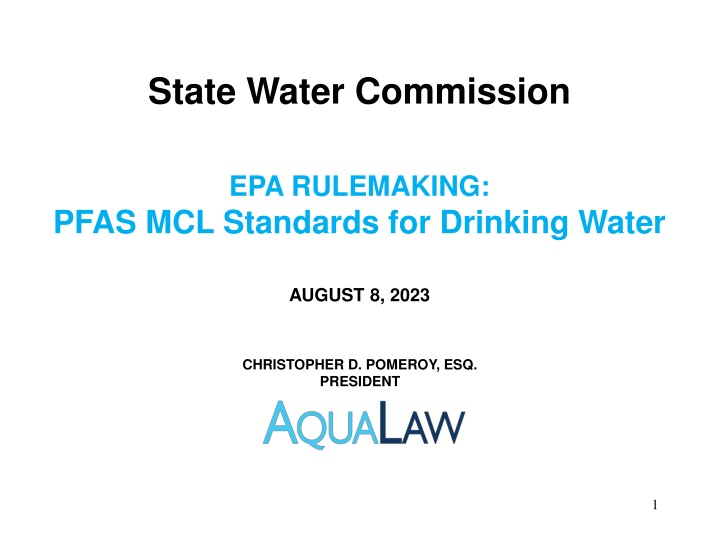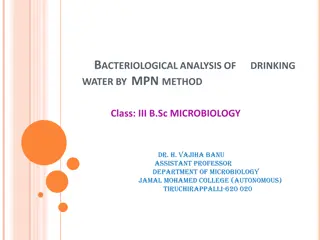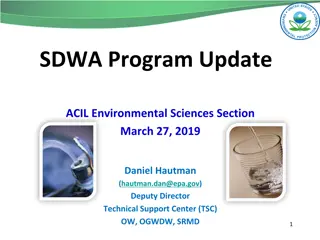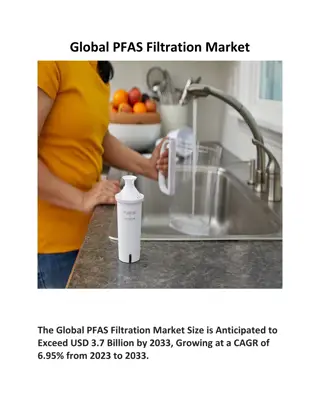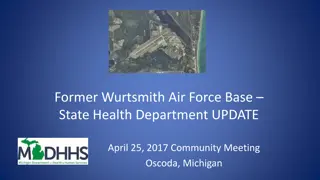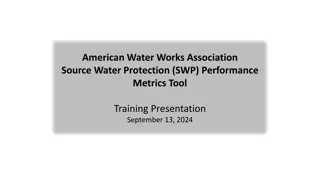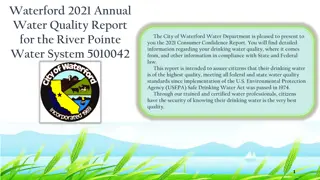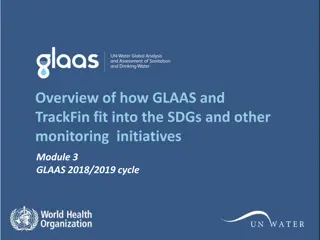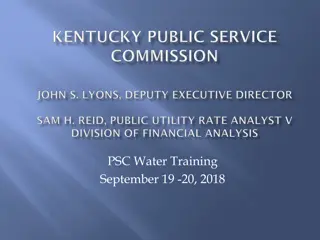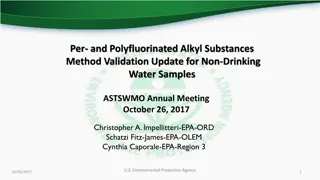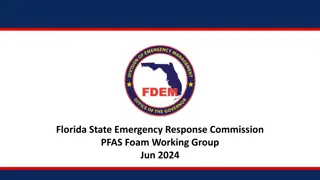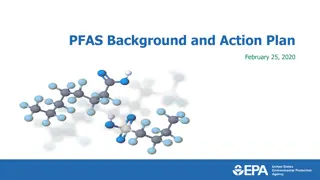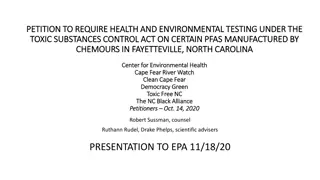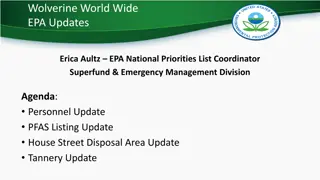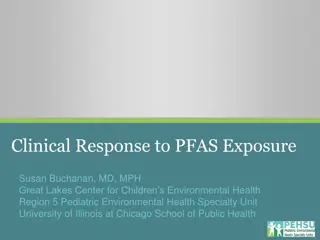State Water Commission: PFAS MCL Standards for Drinking Water
The State Water Commission, EPA rulemaking, and general assembly's key actions are aimed at addressing PFAS contamination in drinking water. Initiatives include setting Maximum Contaminant Levels (MCLs) and compliance deadlines. The EPA's proposed PFAS MCL regulation outlines key requirements and the Hazard Index for evaluating health risks. View the details and proposed measures in the provided images.
Download Presentation

Please find below an Image/Link to download the presentation.
The content on the website is provided AS IS for your information and personal use only. It may not be sold, licensed, or shared on other websites without obtaining consent from the author.If you encounter any issues during the download, it is possible that the publisher has removed the file from their server.
You are allowed to download the files provided on this website for personal or commercial use, subject to the condition that they are used lawfully. All files are the property of their respective owners.
The content on the website is provided AS IS for your information and personal use only. It may not be sold, licensed, or shared on other websites without obtaining consent from the author.
E N D
Presentation Transcript
State Water Commission EPA RULEMAKING: PFAS MCL Standards for Drinking Water AUGUST 8, 2023 CHRISTOPHER D. POMEROY, ESQ. PRESIDENT 1
General Assemblys Key Actions Addressing PFAS HB 596 (2020) Requiring VDH PFAS Occurrence Study, PFAS Workgroup Study Related appropriation HB 1257 (2020) Requiring VDH to adopt Maximum Contaminant Levels ( MCLs ) Related appropriation HB 919 (2022) Requiring VDH to use EPA Safe Drinking Water process for MCLs, or Requiring VDH to adopt EPA s national MCLs when available Also, HB 2189 (2023) Requiring testing by centralized waste treater industrial users of POTW when cleaning or regenerating equipment or media from offsite manufacturers using PFAS 2
EPAs Proposed PFAS MCL Regulation (Proposed March 2023 with EPA Plan to Finalize Dec. 2023) WHO: Applies to Public Water Systems Any system that provides water for human consumption to 15 connections or serves an average of 25 people for 60 days/yr Except EPA is proposing to exempt transient systems Examples Applies to localities, water authorities, public service companies Applies to small system serving a school, office building, or manufacturing plant Does not apply to a hotel, convenience store, or rest stop (transient exemption) WHAT: Key Requirements Monitor for six PFAS Notify the public of PFAS detections Reduce the level of PFAS if an exceedance observed WHEN: Proposed Compliance Deadline 3 years after final adoption, i.e., approx. December 2026 3
EPAs Proposed PFAS MCL Regulation The Hazard Index is a tool used to evaluate potential health risks from exposure to chemical mixtures. *ppt = parts per trillion (also expressed as ng/L) 4
Hazard Index (HI) Component of MCL HI evaluates potential health risks from exposure to chemical mixtures by summing up the fraction of each PFAS Fraction: The level of each PFAS in the water over the level of each PFAS that EPA says does not cause health effects HI Value >1.0 is an exceedance of the MCL EXAMPLE: 5
VA Municipal Drinking Water Assn Background Formed in 2021 to support science-based, sensible, sustainable public policy to help ensure safe and affordable water for Virginians 43 Water Utilities (localities & authorities) serving ~ 90% of Virginians 16 Engineering Firms providing supporting technical expertise Comments to EPA on PFAS MCL Proposal First and foremost, support for safe and affordable water Request EPA confirm MCLs are set at appropriate levels Request EPA correct its underestimate of compliance costs Request EPA provide a phased schedule for implementation 7
EPAs 3-Year Schedule Is Not Feasible for What Water Utilities Would Need to Do Lab expansions and certification for PFAS testing Monitoring for compliance / noncompliance determinations Design and engineering procurement Preliminary engineering analysis Pilot and demonstration testing for technology selection Engineering design for treatment plant upgrades Spending authorization from governing body of the utility Financing arrangements and water rate increases Construction bids, selection, and contracts Equipment order lead times Construction process 8
EPAs Compressed Schedule Creates More Problems Makes current lab testing shortage worse Fails to provide time to use source reduction vs. construction Makes PFAS projects compete with other ARPA infrastructure projects and increases costs for both Worsens public health results when projects for marginal PFAS reduction out-compete those needed for worse PFAS Hurts public confidence in government and water supply when violations occur due to impossible schedules 9
Need Phasing If Nothing Else VMDWA Recommendation to EPA Create a multi-phased approach reducing highest levels first Set 5-year deadline for each phase (42 U.S.C. 300g-1(b)(10)) Acknowledge need for primacy agency (VDH) to grant 3-year extensions as warranted (e.g., complex projects) (40 CFR 142.50) Example of Phasing Phase 1: Achieve 10 ppt for PFOA/PFOS and Hazard Index of 5 effective within 5 years Phase 2: Achieve 7 ppt for PFOA/PFOS and Hazard Index of 3 effective within 10 years Phase 3: Achieve 4 ppt for PFOA/PFOS and Hazard Index of 1 effective within 15 years Note: PPT and HI values above are just illustrations, not MCL recommendations by VMDWA 10
Virginia Is Making Good Progress General Assembly Achieved focused attention on the issue and set the stage for success as national regulations take shape State Agencies Studying occurrences, addressing priority situations through existing authority, targeting grant funding Industry Phasing-out some PFAS, improving products, reducing sources, entering national settlements (3M, Chemours/etc) Water Utilities Evaluating supplies, addressing (fortunately uncommon) priority situations, preparing for future EPA regulations 11
